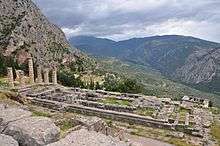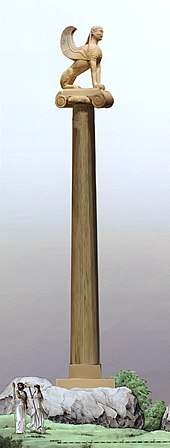Temple of Apollo (Delphi)
The Temple of Apollo, god of music, harmony and light, occupied the most important and prominent position in the Delphic Panhellenic Sanctuary. The edifice with the partially restored colonnade visible today dates to the 4th century BCE; it is the third temple built at the same place. The famous oracle, the Pythia, operated inside the temple, the location chosen, according to tradition, due to a sacred chasm beneath the site emitting vapors, which were inhaled by the Pythias, who then entered a state of delirium and uttering inarticulate cries, which were then turned into equivocal oracles by the priests.[1]
| Temple of Apollo | |
|---|---|
 | |
| Religion | |
| Region | Ancient Greece |
| Deity | Apollo |
| Location | |
| Location | Delphi |
| Geographic coordinates | |
| Architecture | |
| Architect(s) |
|
History

The history of the temple was related by Pausanias in his Description of Greece of the 2nd century CE:
[9] They say that the most ancient temple of Apollo was made of laurel, the branches of which were brought from the laurel in Temple. This temple must have had the form of a hut. The Delphians say that the second temple was made by bees from bees-wax and feathers, and that it was sent to the Hyperboreans by Apollo.
[10] Another story is current, that the temple was set up by a Delphian, whose name was Pteras, and so the temple received its name from the builder… The story that the temple was built of the fern (pteris) that grows on the mountains, by interweaving fresh stalks of it, I do not accept at all.
[11] It is no wonder that the third temple was made of bronze, seeing that Acrisios made a bedchamber of bronze for his daughter, the Lacedaemonians still possess a sanctuary of Athena of the Bronze House, and the Roman forum, a marvel for its size and style, possesses a roof of bronze. So it would not be unlikely that a temple of bronze was made for Apollo…
[13] The fourth temple was made by Trophonius and Agamedes; the tradition is that it was made of stone. It was burnt down in the archonship of Erxicleides at Athens, in the first year of the fifty-eighth Olympiad (548/47), when Diognetus of Crotona was victorious. The modern temple was built for the god by the Amphictyons from the sacred treasures, and the architect was one Spintharus of Corinth.[2]
Pausanias did not mention that the reconstruction after the 548/47 fire was paid for and directed by members of the Athenian Alkmaeonid family who had been forcibly exiled from that city by the tyrant Peisistratos. From Herodotos’ Histories:
As the Alkmaeonids were considering every strategy they could think of against the Peisistratids, they accepted a contract from the Amphityons to build the temple at Delphi, the same one that is there now [as of the mid-fifth century BCE], but which had not yet been built at that time. [3] And since they were not only quite wealthy but also distinguished in their lineage, the temple they constructed turned out more beautiful in all respects than the original plan required; for example, whereas the agreement had called for them to use tufa as the building material, they built the façade of Parian marble instead.[3]
The Alkmaeonid temple, completed by about 511 at the latest, was of the Doric order, with a six by fifteen column peristyle (surrounding colonnade). The sculpted decoration of its pediments was the work of the Athenian sculptor Antenor. The east pediment depicted Apollo’s arrival at Delphi in triumph on his four-horse chariot. The west pediment depicted the battle between gods and giants (gigantomachy).This temple was destroyed during the strong earthquake of 373 BC.[1]
The ruins of Pausanias’ "modern temple" are what we see today. Inaugurated in 330 BCE (43 years after the earthquake), it was also of Doric order, on the same footprint as its predecessor, and made of marble-coated porous stone. Its roof and pedimental decorations, sculpted by the Athenian artists Praxias and Androsthenes, were made of Parian marble. The east pediment was adorned by the figure of Apollo flanked, by his mother Leto, his sister Artemis, and the Muses. The west pediment depicted the god Dionysos among his female votaries, the Thyiades. Persian shields taken as booty by the Athenian’s from the Battle of Marathon in 490 BC were attached to the temple’s metopes along with Gallic shields, spoils of the repulse of Gauls during the 279 BC invasion.[1]
The construction costs of this iteration of the temple were defrayed by contributions from various cities and individuals. Much of the stone from the Alkmaeonid temple was reused, and replacements for the broken pieces was purchased from the Corinthians and ferried across the Corinthian Gulf to the town of Kirra before being hauled up the mountain to Delphi.[4]
Inscribed on a column in the pronaos (the porch before the temple’s cella), according to ancient writers, were three of the Delphic maxims of the Seven Sages: ΓΝΩΘΙ ΣΑΥΤΟΝ (know thyself), ΜΗΔΕΝ ΑΓΑΝ (nothing in excess), and ΕΓΓΥΑ, ΠΑΡΑ ΔΑΤΗ (surety brings ruin)[5]as well as the enigmatic Delphic symbol “Ε”.[1]
The temple survived until AD 390, when the Roman emperor Theodosius I silenced the oracle by destroying the temple and most of the statues and works of art in the name of Christianity.[6] The site was completely destroyed by zealous Christians in an attempt to remove all traces of Paganism.[6]
The ruins of this temple decay at a faster rate than some of the other ruins on the Southern slopes of Mount Parnassos. This is mostly due to the use of limestone, a softer material, along with porous stone.[7]
See also
References
- Greek Ministry of Culture and Tourism, 10th Ephorate of Prehistoric and Classical Antiquities, from the information plaque at the temple.
- Pausanias. Description of Greece. Translated by Jones, W.H.S.; Ormerod, H.A. Book X.5.9-13.
- Herodotos. The Histories. pp. Book V.62.2-3.
- Harding, Phillip (1985). Translated Documents of Greece and Rome: From the end of the Peloponnese War to the battle of Ipsus. Cambridge, UK: Cambridge Univ. Press. pp. 81–81, 108–09. ISBN 0-521-29949-7.
- Eliza G. Wilkins ΕΓΓΥΑ, ΠΑΡΑ ΔΑΤΗ in Literature Classical Philology Volume 22, Number 2 Apr., 1927 p121 https://www.journals.uchicago.edu/doi/abs/10.1086/360881
- Trudy Ring, Robert M. Salkin, Sharon La Bod, International Dictionary of Historic Places: Southern Europe; Page 185;
- "Temple of Apollo at Delphi". Ancient-Greece.org. Ancient-Greece.org. Retrieved 2 October 2017.